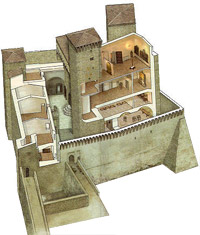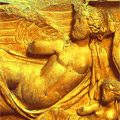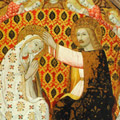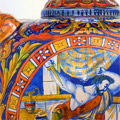Museo Civico Rocca Flea - Rocca's Flea Museum
 Since 1999 the civic museum has been housed in the fortress known as the Rocca Flea. Its name, which derives from the nearby river Flebeo, later called Flea, already appears in the 12th century documents. In the succession of the varius domination imposed on the town, the fortress was first occupied by Frederick Barbarossa's troops, then by those of the pope and, in 1208, by those of Gelph Perugia. Damaged by many conflicts, it was restored by Frederick II around 1242.
Since 1999 the civic museum has been housed in the fortress known as the Rocca Flea. Its name, which derives from the nearby river Flebeo, later called Flea, already appears in the 12th century documents. In the succession of the varius domination imposed on the town, the fortress was first occupied by Frederick Barbarossa's troops, then by those of the pope and, in 1208, by those of Gelph Perugia. Damaged by many conflicts, it was restored by Frederick II around 1242.
Since 1999 the Rocca Flea is the civic museum. Its name, which derives from the nearby river Flebeo, later called Flea, already appears in the 12th century documents. In the succession of the varius domination imposed, the fortress was first occupied by Frederick Barbarossa's troops, then it was under the pope's power and, in 1208, is under the Gelph Perugia. Damaged by many conflicts, it was restored by Frederick II around 1242.
In 1350, when Gualdo was subjugated by Perugia again, the construction began the town's own emblem. In the 16th century, it became the residence of the papal legates and, as a consequence of it, part of the interiors were decorated with frescoes.
After the Unification of Italy, it was turned into a prison and used still the 1985. After it, it was restored and used as a museum. It's shared in three sections: the archaeological side, with Gualdo Tadino's findings that take place from the XIII-XII cent. since the Romans and Longobard's period and also other remains of differents population that in the past lived in this area; the art gallery where it's possible to see painting in tempera of the XIV-XV cent. most of them made by Matteo da Gualdo. Its' possible to admire also quite important operas like the majestic "Polittico" (this opera is considered his masterpiece) realized by Niccolò di Liberatore known as the "Alunno". The pottery's section is the last part of the museum, here takes place the pottery realized between the end of the 1800th and the half part of the 1950th. They has been made by the technique of Mastro Giorgio (gold and ruby).
The collection of paintings was originally sites in the small mediaval palazzo in Via Calai, since 1919. In 1966 the Art Gallery, thanks to Francesco Santi, was transfered in the Church of San Francesco since 1979. Paintings cames from the city's churches and mostly of them are by Matteo da Gualdo.
The collections
Archaeological collection
 In this section we can admire findings from the three archaelogical sides of Gualdo Tadino. They are dated from the 4th century B.C.till the Middle Ages. In the first room, there are findings of III-II century B.C. and the most important ones is the Roman Sarcophagus with the shield hold up by two wing victories.In the second room, we can admire umbrian's remains of the XIII-XI cent. Quite important is the terminal stone wtitten by them alphabetic, where they recognoize the land of Tadino.
In this section we can admire findings from the three archaelogical sides of Gualdo Tadino. They are dated from the 4th century B.C.till the Middle Ages. In the first room, there are findings of III-II century B.C. and the most important ones is the Roman Sarcophagus with the shield hold up by two wing victories.In the second room, we can admire umbrian's remains of the XIII-XI cent. Quite important is the terminal stone wtitten by them alphabetic, where they recognoize the land of Tadino.
Painting collection:
 At the last floor of the fortress take place the art gallery where it's possible to see painting in tempera of the XIV-XV century. Most of them are made by Matteo da Gualdo, an eclectic artist that beautify Gualdo's churches. It's possible pass through his artistic career from 1462 to 1497. Other important operas are: "L'incoronazione della Vergine" by Sano di Pietro e "Sant'Anna con la Vergine Bambina" by Antonio da Fabriano. In the next room we find some operas by Girolamo and Bernardo, respectively son and nephew of Matteo da Gualdo. An other important painter is Niccolo di Liberatore known as Alunno and his "Polittico" (1471). It was painted for the high altar in the local church of San Francesco. In the 18th century it was moved to a chapel in the same church and due to lack of space the row of small arches between the predella and the part above was removed, and now is a part of the Museum's collection.
Ceramical collection
At the last floor of the fortress take place the art gallery where it's possible to see painting in tempera of the XIV-XV century. Most of them are made by Matteo da Gualdo, an eclectic artist that beautify Gualdo's churches. It's possible pass through his artistic career from 1462 to 1497. Other important operas are: "L'incoronazione della Vergine" by Sano di Pietro e "Sant'Anna con la Vergine Bambina" by Antonio da Fabriano. In the next room we find some operas by Girolamo and Bernardo, respectively son and nephew of Matteo da Gualdo. An other important painter is Niccolo di Liberatore known as Alunno and his "Polittico" (1471). It was painted for the high altar in the local church of San Francesco. In the 18th century it was moved to a chapel in the same church and due to lack of space the row of small arches between the predella and the part above was removed, and now is a part of the Museum's collection.
Ceramical collection
 Here take place the pottery realized between the end of the 1800th and the half part of the 1950th . They are realized in gold and ruby with the old shining technique made by Mastro Giorgio. It's possible to admire, in the reliquary manufactured, products made in the majour pottery workshop of the city by the family Rubboli and Santarelli.
Here take place the pottery realized between the end of the 1800th and the half part of the 1950th . They are realized in gold and ruby with the old shining technique made by Mastro Giorgio. It's possible to admire, in the reliquary manufactured, products made in the majour pottery workshop of the city by the family Rubboli and Santarelli.
History of Gualdo Tadino
The city of Gualdo Tadino born on the slopes of mount Serra Santa, The name of the town derives from the Longobard word "Wald" that means wood. There are many archaeological remains that prove which in Gualdo lived different populations since the prehistorical era: a stone with Umbrian inscription (IV cent. B.C.) and some others findings (bronze objects and two gold discs dating back to the 12th century B.C.) were found in Santo Marzio.
When Romans conquest the Umbria (III century B.C.), Tadinum developed in the area of San Antonio di Rasina, along the Flaminia's street, the road that connected Rome to Rimini, . In the 6th century B.C. the Greek-Gotic war took place along the Flaminia's street, that join Rome to the Byzantine possessions and to Ravenna. After many dominations, the city was destroyed by a big fire and rebuilt by permission of Frederick II in the 13th century and still now it maintain the same outlooking.
At the end of the 13th century it was under the control of Perugia still the 1469, when it became an autonomous legation of the Papal State. In the 1833 Gregory XVI conferred "city" status to it and changed its name from Gualdo di Nocera to Gualdo Tadino.
Opening calendar
April - May
Open from Thursday to Sunday: 10.00-13.00/15.00-18.00
Open also monday 1 May (Labour day)
June - September
Open from Tuesday to Sunday: 10.00-13.00/15.00-19.00
Closed on Monday.
October - March
Open from Thursday to Sunday: 10.00-13.00/15.00-18.00
Open Saturday and Sunday, 1-2 November, 8 Decembers, from the 23trd December to 6 January
Closed on the 25th December and first of January
Ticket prices
Adults price: 5,00euros
Reduced*: 3,00euros
Global ticket**: 6,00euros
* Reduced: for children from 7 to 18, college students, over 65, groups above 15 people.
** Includes the entrance to all the Museums of the city, it offers the chance to buy for a special price an only ticket for the "Museo Civico Rocca Flea" and the "Museo Regionale dell'Emigrazione Pietro Conti".
We suggest to book our tour if you are a group for a better service.








